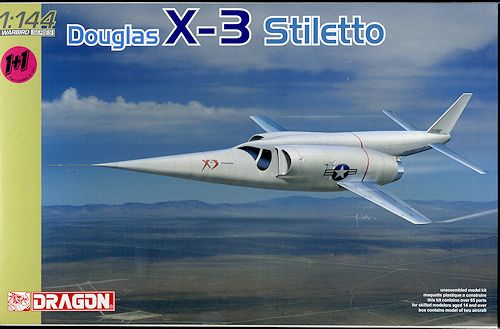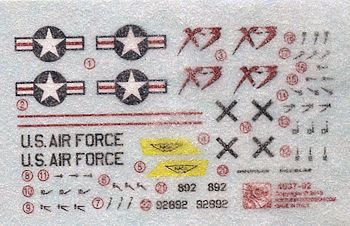
Dragon 1/144 X-3 'Stiletto'
| KIT #: | 4637 |
| PRICE: | $20.00 SRP |
| DECALS: | One option per kit |
| REVIEWER: | Scott Van Aken |
| NOTES: | Two kits |

| HISTORY |
The Douglas X-3 Stiletto was the sleekest of the early experimental aircraft, but its research accomplishments were not those originally planned. It was originally intended for advanced Mach 2 turbojet propulsion testing, but it fell largely into the category of configuration explorers, as its performance (due to inadequate engines) never met its original performance goals. The goal of the aircraft was ambitious — it was to take off from the ground under its own power, climb to high altitude, maintain a sustained cruise speed of Mach 2, then land under its own power. The aircraft was also to test the feasibility of low-aspect ratio wings, and the large-scale use of titanium in aircraft structures.
Construction of a pair of X-3s was approved on 30 June 1949. During development, the X-3's planned Westinghouse J46 engines were unable to meet the thrust, size and weight requirements, so lower-thrust Westinghouse J34 turbojets were substituted, producing only 4,900 lbf (21.8 kN) of thrust with afterburner rather than the planned 7,000 lbf (31.3 kN). The first aircraft was completed and delivered to Edwards Air Force Base, California, on 11 September 1952.
The X-3 featured an unusual, rakish shape of a long cylindrical fuselage with tiny trapezoidal wings. One of the design considerations was to create the smallest and "thinnest" shape possible in order to achieve a streamlined planform. The extended nose was to allow for the provision of test equipment while the semi-buried cockpit and windscreen was designed to alleviate the effects of "thermal thicket" conditions. The low aspect ratio, unswept wings were designed for high speed and later the Lockheed design team used data from the X-3 tests for the similar F-104 Starfighter wing design. Due to both engine and airframe problems, the partially completed second aircraft was cancelled, and its components were used for spare parts.
The X-3 was severely underpowered and difficult to control. Its takeoff speed was an unusually high 260 kts (482 km/h). More seriously, the X-3 did not approach its planned top speed. Its first supersonic flight required that the airplane make a 15° dive to reach Mach 1.1. The X-3's fastest flight, made on 28 July 1953, reached Mach 1.208 in a 30° dive.
| THE KIT |
 Dragon is continuing with its X-plane series by producing a pair of X-3s for their 1/144 series. All of the sprues are in clear plastic. This is an interesting way to do these kits, but there is a method to this. The kit includes a pair of engines and since the plastic for the separate canopy is so thick, one would not see the bang seat that is also included.
Dragon is continuing with its X-plane series by producing a pair of X-3s for their 1/144 series. All of the sprues are in clear plastic. This is an interesting way to do these kits, but there is a method to this. The kit includes a pair of engines and since the plastic for the separate canopy is so thick, one would not see the bang seat that is also included.  - Realistic rudders reproduced
- Realistic rudders reproducedSince it is such a basic kit, instructions all fit onto a section of one side of a sheet of paper. Markings are provided for the lone aircraft at two different times of its life. One is the very minimalist marked box art plane while the other has full USAF and NACA logos. The aircraft was white with aluminum/titanium wings/tailplanes and hot section behind the exhaust. The decal sheet (which is shown with its wax paper cover in place) is nicely done.
| CONCLUSIONS |
Those of us who have suffered through the Revell and Lindberg X-3s and couldn't see paying the price of the resin ones will be quite happy with this one. Since all the X-plane kits offer two full kits, you can do one in flight and one on the ground. I am sure that others will be in the works so can the X-2, X-4 and X-5 be far behind?
| REFERENCES |
http://en.wikipedia.org/wiki/X-3_Stiletto
May 2013
Thanks towww.dragonmodelsusa.com for the preview kit. Get this one today at your local shop.
If you would like your product reviewed fairly and fairly quickly, please contact the editor or see other details in the